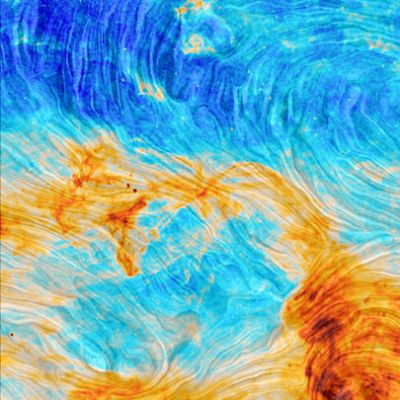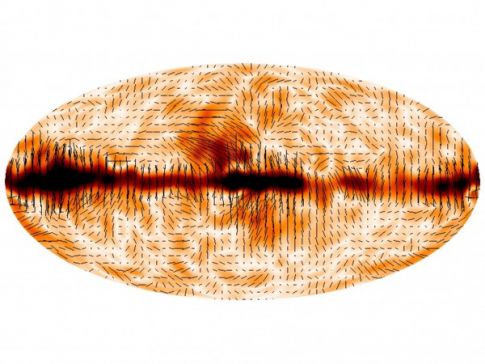
ESA-Planck
This image isn't a close-up of part of Van Gogh's "The Starry Night," but it is a patch of sky showing the swirling the magnetic field inferred from Planck data. (Image via ESA-Planck Collaboration, prepared by Marc-Antoine Miville-Deschenes.)
Yesterday, the Planck collaboration announced more CMB results and there's been plenty of news coverage. There aren't many dramatic findings. If anything, discrepancies between Planck's earlier data and WMAP's CMB data seem to be reducing, as more Planck data comes in. From Adrian Cho, quoting Nazzareno Mandolesi, a cosmologist with Italy's National Institute for Astrophysics in Bologna, in Science:
"WMAP and Planck had disagreed by about 1% to 1.5% on their absolute temperature measurements, Mandolesi explains. A recalibration reduces the mismatch to less than 0.3%, within the statistical uncertainties, he says. Regarding the parameters of the cosmological theory, Planck researchers derived a slightly longer age and a slightly smaller current expansion rate for the universe than WMAP showed, Mandolesi says. But with more data, the numbers have shifted slightly and now agree to within the experimental uncertainties, he says."
It does help us narrow in on what dark matter may be, or rather what it's not. From Dennis Overbye in the NYT:
"Recently space experiments like NASA's Fermi Gamma-ray Space Telescope and Alpha Magnetic Spectrometer have recorded excess cosmic ray emissions that, some say, could be evidence of a certain kind of dark matter particles colliding and annihilating one another.
"After Planck, we need another answer for those experiments, the French agency concluded in a statement."
and
"Planck dealt a blow to another possible dark matter candidate, namely a brand of the ghostly particles known as neutrinos. Physicists have known of three types of neutrinos for some time and have wondered if there were any more, whose accumulated mass would affect the evolution of the universe. Planck's results leave little room for a fourth kind, so-called sterile neutrinos."
While we're waiting for the joint analysis by Planck and the BICEP2 team to say something about the latter's claimed evidence of B-modes supporting inflation--and while I'm subtly plugging the podcast by opening a few threads today--I'll invite you to listen to our podcast interview with astrophysicist Andrew Liddle from October to help put things into perspective.

ESA-Planck
Planck's polarization map of the CMB.